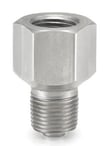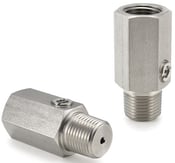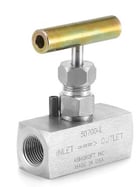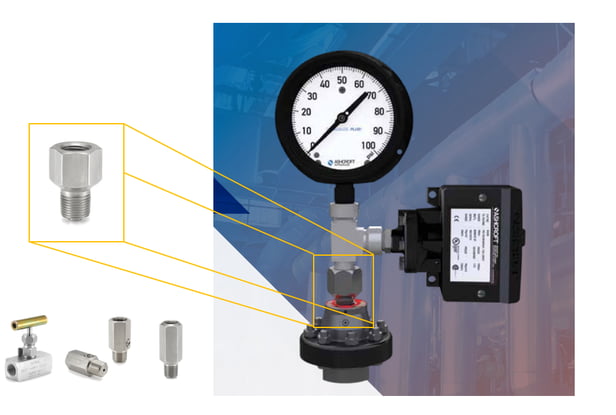Subscribe now and get the latest blog posts delivered straight to your inbox.
When would I use a dampening device with a diaphragm seal?

In challenging process applications, diaphragm seals (isolators) are often required to protect pressure instruments from the corrosive media and/or large particulates found in the process. These materials can impact, or even impede, the accuracy of your instruments and wreak havoc on your operation. In harsh applications that involve pressure spikes, erratic vibration and pulsation, your diaphragm seal may need a layer of added protection to ensure the safety of your instruments.
With 10+ years in the pressure and temperature instrumentation industry and product leader for Ashcroft diaphragm seal products, I am often asked to recommend a solution for this particular challenge. More often than not, after I gather all pertinent information about the customer's specific challenge, the solution is a dampening device.
Read on to learn when and why a dampening device may be recommended for your application, the different styles that are available and how they function. When you are done, you will have a greater understanding of how diaphragm seals and dampening devices can work together to keep your operation running safely. You will also see links to additional related resources that you can refer to at your convenience.
What types of applications use diaphragm seals and dampening devices?
A pumping system is one example of a challenging application where we may recommend a dampening device to work with a diaphragm seal for added protection of your pressure instrumentation. We work closely with system integrators, skid builders, pump system manufacturers as well as process end users to determine the best seal and dampening device for their specific needs.
End users including chemical plants, water treatment plants or refineries have pressure instrumentation throughout the piping systems. They also have pressure instruments on the pump systems that move the process from station to station. These pump systems are critical for the refining process and typically have a set of instrumentation on both the suction and discharge sides of the pump. In both cases, these pump systems are sending out pressure pulsations.
Pressure pulsations/vibrations occur in the form of low frequency/high amplitude (long continuous strokes) or high frequency/low amplitude (short quick strokes). Exposing your gauge to these surges in process pressure or pulsations of any kind can cause:
- Poor dial readings
- Significant wear and tear on internal components
- Reduced lifespans
- Complete inoperability
In one example, extreme pulsation caused metal shavings to be projected through the pinhole of the gauge case/dial.
Corrosion can occur when the wetted parts of an instrument are not compatible with the process material. When this happens:
- Chemicals, solids or other abrasive substances come in contact with the pressure-sensing element of the gauge.
- The instrument will not be able to accurately measure the process pressure.
- The instrument will eventually fail.
- The safety of your process will be compromised, putting the entire operation and operators at risk.
What are the different types of dampening devices?
Dampening devices are available in many styles, each designed with a specific purpose. For this article, we will focus on three pulsation flow restrictors offered by Ashcroft. Styles include:
1. Sintered/Filtered. This style is designed to protect your pressure instrument from sudden pressure pulsation spikes or fluctuations and is also used for dampening and filtering. The Ashcroft® 1112 Pressure Snubber is one example that features a porous metal disc that acts as a clogged filter slowing the movement down from inlet to outlet and reducing the effects of pulsation. This action also reduces the responsiveness of the instrument.
Before selecting a filtered or sintered disc be sure to select a porosity that is designed for oils when using with a diaphragm seal as some porosities are tighter and meant for clean air or water.
Figure 1. Ashcroft® 1112 Pressure Snubber.

2. Piston. To reduce damaging pressure surges and keep components functioning properly, the piston-style dampener uses an adjustable pin that restricts pulsation. The Ashcroft® 1106 Pulsation Dampener is an example that uses five different-sized pinholes, allowing the user to vary the dampening amount to suit the application requirements. The piston thrusts up and down its chamber as pressure increases and decreases keeping the pathway clear from particulates, making it a self-cleaning device. It may be used in either vertical or horizontal positions.
Figure 2. Ashcroft®1106 Pulsation Dampener.

3. Adjustable. The third design available is an adjustable snubber such as the Ashcroft® PD02 Pressure Snubber. There are benefits and drawbacks to this design. For installing/assembling/filling purposes the adjustable snubber is ideal. Technicians can open the snubber wide and allow for easy fill/calibration of the diaphragm seal.
They can then tighten the snubber down to the proper dampening level. The part to consider is when this is practiced on smaller pressure spans the effect of adjusting the snubber changes the overall volume in the system and can impact the accuracy of the reading. If you’re using a product that has a zero/span adjustment then you can bypass this concern. Otherwise, this must be considered when critical readings or switch set points are involved.
This dynamic also applies to throttle valves, which are also used to protect against pulsations. Putting valves above diaphragm seals can be misleading in general and we try to avoid those assemblies. Throttle valves may be used for dampening pressure pulsations. However, they also affect the internal volume of the assembly and can impact accuracy as it is adjusted.
Figure 3. Ashcroft® PD02 Pressure Snubber.

Figure 4. Ashcroft® 7001 Throttle Valve.

Why using dampening devices is critical.
Many diaphragm seal assemblies include both a pressure gauge and a switch. When this happens, the gauge may have a dampening on the movement or a case fill. But if the gauge is exposed to pulsations the pressure switch would also. To protect both the pressure gauge and the pressure switch it is important to use a dampener in front of the gauge and switch.
Figure 5. Diaphragm Seal Assembly.

Additional considerations when using a dampening device.
- Throttle screws are commonly used in pressure gauge applications. Ashcroft standardizes throttle screws for low-pressure ranges, liquid-filled gauges and gauges with dampened movement (aka PLUS!™ Performance).
- Throttle screws and plugs are installed in the communication hole of a pressure connection to reduce the orifice minimizing the effects of pressure pulsations. However, they can be problematic when trying to properly fill a diaphragm seal assembly. The orifice is too small to allow the liquid fill to push out air that may be trapped in the system of the assembly. Because of this, we omit the throttle screw when installing diaphragm seals. By omitting the throttle screw, the pressure gauge may now be exposed to the pressure pulsation, making it even more important to include a dampening device.
- Diaphragm seals themselves also provide some dampening effects on pressure pulsations. Although this is true to some degree, the omission of a throttle screw does counteract those efforts. It is not uncommon to see pulsation effects on instruments through the dampening of a diaphragm seal. In this situation, I always recommend an external dampener such as a pressure snubber or pulsation dampener if pressure pulsations are likely.
Did you get the answer you needed?
With an understanding of when you would consider adding a dampening device to your diaphragm seal assembly, you may still have questions. Feel free to contact one of our product experts for answers. In the meantime, below are a few related resources that may help.
- Liquid-Filled vs. Direct Drive Pressure Gauges vs. PLUS!™ Performance
- Ashcroft Pressure Gauge with PLUS!™ Performance
- Best Practices for Installing Flanged Diaphragm Seals
- How Does Temperature Affect Pressure Gauge Performance?
- PLUS!™ Performance Product Guide
John Girard, Business Development Lealer
John Girard is currently the Business Marketing Leader for Diaphragm seals, Process Gauges and Accessories at Ashcroft. Formerly, he was the Territory Sales Manager responsible for supporting the distribution network in the Northeast. He began with Ashcroft as a Product Specialist for mechanical pressure gauges and accessories. He transitioned to a Sales Engineer role working with engineering firms on specifications. John achieved an M.B.A from Johnson & Wales University and has 10+ years of experience working with Sales and Marketing.
Topics:





















